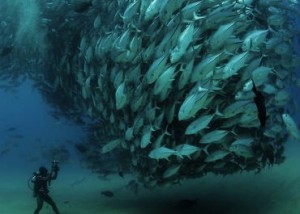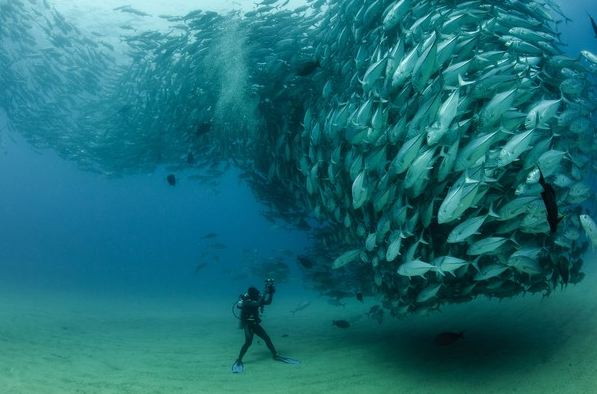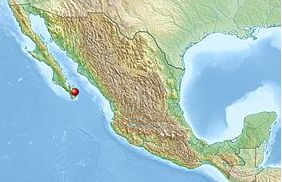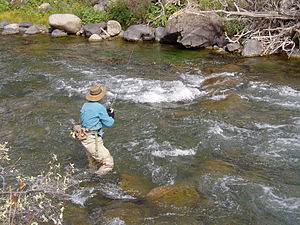Biologists campaign to save fish
By Tang Chia-ling, Chung Li-hua and Jason Pan / Staff reporters, with Staff writer
A Napoleonfish, an endangered species, is pictured in this undated photograph.
Photo provided by Taiwanese Coral Reef Society
Marine biologists and conservation groups yesterday launched a signature drive for a petition urging the government to add two endangered bulbous-head fish species to the protected species list.
The petition will ask the Council of Agriculture to add the Napoleonfish and the Bumphead Parrotfish onto the Schedule of Protected Species List under the Wildlife Conservation Act (野生動物保育法).
The Napoleonfish is also known as the humphead wrasse, and its name in Chinese means “dragon king fish.” The bumphead parrotfish — Bolbometopon muricatum — is also known as the double-headed parrotfish. Both species are slow growing and long-lived, with delayed reproduction and low rates of replenishment.
“The number of these two fish species still left is lower than the number of Chinese white dolphins in the waters around Taiwan’s west coast,” Taiwanese Coral Reef Society (TCRS) chairperson Cheng Ming-shou (鄭明修) said.
TCRS secretary-general Chang Ming-lung (張銘隆) said that both the Napoleonfish and the bumphead parrotfish are considered giant species of the marine reef community, and they used to be quite common in the coral reefs near the shores of Taiwan.
However, they are now on the brink of extinction, after many years of unregulated harvesting by fishermen and spear fishing by recreational divers, he said.
“We estimate that there are only about 30 individuals of these two species left, which is less than the 66 recorded for the Chinese white dolphin in the Taiwan Strait,” he said.
“The Forestry Bureau held a meeting to discuss adding these two fish species to the Schedule of Protected Species List. However, Department of Fisheries officials thought there was insufficient data for assessment. So more data will need to be provided, and this issue will be put on the agenda of next month’s Wildlife Protection Advisory Committee meeting,” the head of the Forestry Bureau’s Protected Species Division, Guang Li-hao (管立豪), said.
It is quite alarming that it has been more than 10 years since a single Napoleonfish or bumphead parrotfish was sighted in the marine reef territories surrounding Taiwan and its offshore islands of Green Island, Lanyu (蘭嶼) and Penghu and recorded in the survey conducted by his organization, Chang said.
TCRS have sent letters to the Conservation Division of the Forestry Bureau, requesting to place Napoleonfish and bumphead parrotfish onto the Schedule of Protected Species List.
“My research programs focus on the waters around Kenting (墾丁) and the Pratas Islands (Dongsha Islands, 東沙群島). During my diving expeditions over the past decade, I have rarely spotted the Napoleonfish,” said Chen Cheng-ping (陳正平), a Taiwan Ocean Research Institute researcher.
Cheng, who is a researcher at the Biodiversity Research Center of Academia Sinica, said the Napoleonfish was the largest fish in the nation’s coral reef ecosystem, and can weigh up to 200kg.
However, due to overfishing, “most Napoleonfish have been eaten. We hardly see them anymore in the waters surrounding Taiwan,” he said.
“The bumphead parrotfish is easy prey for fishermen, because it has a fixed habitat and keeps regular sleeping hours,” Cheng said.
Both of these species are excellent attractions that pull in tourists and divers to renowned tourist spots in coastal recreational parks around the world and protected marine areas around tropical islands, he said.
Full Article: http://www.taipeitimes.com/News/taiwan/photo/2013/01/28/2008082939
The petition will ask the Council of Agriculture to add the Napoleonfish and the Bumphead Parrotfish onto the Schedule of Protected Species List under the Wildlife Conservation Act (野生動物保育法).
The Napoleonfish is also known as the humphead wrasse, and its name in Chinese means “dragon king fish.” The bumphead parrotfish — Bolbometopon muricatum — is also known as the double-headed parrotfish. Both species are slow growing and long-lived, with delayed reproduction and low rates of replenishment.
“The number of these two fish species still left is lower than the number of Chinese white dolphins in the waters around Taiwan’s west coast,” Taiwanese Coral Reef Society (TCRS) chairperson Cheng Ming-shou (鄭明修) said.
TCRS secretary-general Chang Ming-lung (張銘隆) said that both the Napoleonfish and the bumphead parrotfish are considered giant species of the marine reef community, and they used to be quite common in the coral reefs near the shores of Taiwan.
However, they are now on the brink of extinction, after many years of unregulated harvesting by fishermen and spear fishing by recreational divers, he said.
“We estimate that there are only about 30 individuals of these two species left, which is less than the 66 recorded for the Chinese white dolphin in the Taiwan Strait,” he said.
“The Forestry Bureau held a meeting to discuss adding these two fish species to the Schedule of Protected Species List. However, Department of Fisheries officials thought there was insufficient data for assessment. So more data will need to be provided, and this issue will be put on the agenda of next month’s Wildlife Protection Advisory Committee meeting,” the head of the Forestry Bureau’s Protected Species Division, Guang Li-hao (管立豪), said.
It is quite alarming that it has been more than 10 years since a single Napoleonfish or bumphead parrotfish was sighted in the marine reef territories surrounding Taiwan and its offshore islands of Green Island, Lanyu (蘭嶼) and Penghu and recorded in the survey conducted by his organization, Chang said.
TCRS have sent letters to the Conservation Division of the Forestry Bureau, requesting to place Napoleonfish and bumphead parrotfish onto the Schedule of Protected Species List.
“My research programs focus on the waters around Kenting (墾丁) and the Pratas Islands (Dongsha Islands, 東沙群島). During my diving expeditions over the past decade, I have rarely spotted the Napoleonfish,” said Chen Cheng-ping (陳正平), a Taiwan Ocean Research Institute researcher.
Cheng, who is a researcher at the Biodiversity Research Center of Academia Sinica, said the Napoleonfish was the largest fish in the nation’s coral reef ecosystem, and can weigh up to 200kg.
However, due to overfishing, “most Napoleonfish have been eaten. We hardly see them anymore in the waters surrounding Taiwan,” he said.
“The bumphead parrotfish is easy prey for fishermen, because it has a fixed habitat and keeps regular sleeping hours,” Cheng said.
Both of these species are excellent attractions that pull in tourists and divers to renowned tourist spots in coastal recreational parks around the world and protected marine areas around tropical islands, he said.
Full Article: http://www.taipeitimes.com/News/taiwan/photo/2013/01/28/2008082939




































 In 1998 the company moved to larger premises, but by 1999 further demand forced a second move to their current base in Mosgiel.
In 1998 the company moved to larger premises, but by 1999 further demand forced a second move to their current base in Mosgiel. The EHT (Enclosed Hard Top) design is a fine entry, deep-vee hull (deadrise is 20° at the transom) with no strakes and the downturned chines becoming pronounced towards the Portafino-style stern.
The EHT (Enclosed Hard Top) design is a fine entry, deep-vee hull (deadrise is 20° at the transom) with no strakes and the downturned chines becoming pronounced towards the Portafino-style stern. The boat we trialed, Southern Extreme, was fitted with a permanently mounted Sarca anchor, handled by a Maxwell Freedom 500 warp and chain capstan. Access to the chain locker was through a hatch in the forward bulkhead, and the controls (with thermal overload) are at the helm position. Access to the bow is best through the large hatch in the cabin roof, an easy spot to switch the capstan to freespool from, should you wish to drop the anchor faster than allowed by the wind-down system.
The boat we trialed, Southern Extreme, was fitted with a permanently mounted Sarca anchor, handled by a Maxwell Freedom 500 warp and chain capstan. Access to the chain locker was through a hatch in the forward bulkhead, and the controls (with thermal overload) are at the helm position. Access to the bow is best through the large hatch in the cabin roof, an easy spot to switch the capstan to freespool from, should you wish to drop the anchor faster than allowed by the wind-down system. A good-sized dash is fitted with a back lip, and is carpet covered as an aid to stopping items bouncing or sliding off, as well as to reduce internal glare on the windows. A Furuno Navnet unit was fitted at the helm, the large screen allowing good-sized readouts of both chartplotter and sounder on split screen. It also displays the image from the 24nm Furuno radar mounted outside on the rocket launcher.
A good-sized dash is fitted with a back lip, and is carpet covered as an aid to stopping items bouncing or sliding off, as well as to reduce internal glare on the windows. A Furuno Navnet unit was fitted at the helm, the large screen allowing good-sized readouts of both chartplotter and sounder on split screen. It also displays the image from the 24nm Furuno radar mounted outside on the rocket launcher. This hull is a stable work platform. It has a big cockpit, with good footing provided by chequerplate decks covered with tube mat, and can easily fish four anglers. There are six aluminium through-gunwale rodholders, with gimbal pins at the appropriate angles. A large baitstation mounted on the transom provides a further two rodholders.
This hull is a stable work platform. It has a big cockpit, with good footing provided by chequerplate decks covered with tube mat, and can easily fish four anglers. There are six aluminium through-gunwale rodholders, with gimbal pins at the appropriate angles. A large baitstation mounted on the transom provides a further two rodholders.